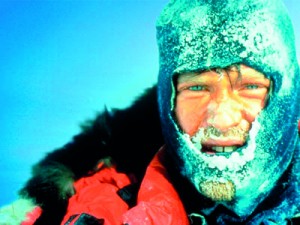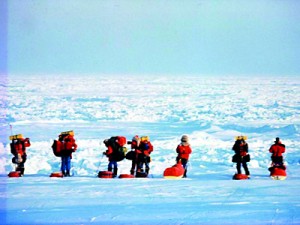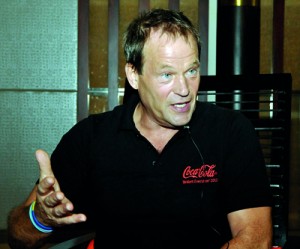He will never give up on Antarctica
View(s):
Incredible journey: Photos courtesy 2041.com
Sir Robert Swan used to have blue eyes. That changed when he set out on a journey to the South Pole. Prolonged exposure to the harmful UV rays streaming through the hole in the ozone above the Antarctic landscape left his eyes a paler shade of grey and his face burned to a crisp.
When they reached the end of their journey on January 11, 1986 Robert had lost 33kg over 70 days, had covered 900 miles on foot hauling a 350 pound sled and had endured temperatures as low as -33°C while trudging headfirst into winds travelling at 40 knots. Not satisfied, he would replicate his feat at the other end of the world – becoming on May 14, 1989, the first human to have walked to both Poles. It was the realisation of a dream that he had had since he was 11 years old.
As a boy, Robert was depressed by the state of the world – the Cold War raged as humanity contemplated the fallout from a nuclear war. “And then I saw the film about Antarctica… At the age of 11 for me, this place began the dream, because it seemed like our world was crazy and this one place wasn’t,” he says. In his early twenties, Robert began his campaign in earnest. He lived in a warehouse by the Thames and drove a taxi cab at night, spending his waking hours jockeying for funds. It took him five years and over 1,000 sponsors to raise the $5 million he needed for his first expedition.
From the start, Robert’s heroes shaped his quest. He was a fan of Sir Ernest Shackleton and Roald Amundsen but it was Captain Robert Falcon Scott whom he decided to name his expedition after. In 1912, Scott and his team succumbed to starvation and the cold, making the title of Robert’s own expedition – ‘In the Footsteps of Scott’ – a little worrying. Robert’s decision to make the journey with his two companions unassisted, i.e. without any radio communication or emergency support, also owed much to his admiration for those early explorers.
“We wanted to respect Scott, Shackleton and Amundsen,” he says. “They didn’t have radios. They couldn’t call up Mommy from half way and say ‘I want to come home’. We wanted to touch their isolation and their commitment.” He knew, however, that he was going into hostile territory. “Antarctica – it wants you dead… but if you get past that and respect it, it certainly is a very beautiful place but very dangerous as well,” he says ruefully. “It’s like a mirror. You can look at yourself in that mirror and find yourself not all who you think you are.”
His lectures today are peppered with jokes about ice in his underwear and crossing crevasses (an estimated 6,000 scar the South Pole alone) but the trip would take him to the very edge of his resilience. “You don’t think in terms of reaching the South Pole, you think in terms of tonight, you think in terms of an hour ahead. On a really terrible day, you think in terms of your next step,” he says.
The two Poles would challenge Robert in different ways. In the South they walked nine hours a day, in the North 12 -14 hours, but while the bleakness of the former taxed them emotionally, the latter was a physical ordeal. “You’re walking across a frozen ocean, an ocean which in our case, was melting,” he remembers. Over 500 miles from the nearest land, the ice had begun to disintegrate under their feet months ahead of schedule. People went into the water many times and had to be rescued – the entire team of 8 nearly died. Robert himself was in terrible pain – while crossing an ice ridge, a sled crashed into him, leaving him with a slipped disk in his back. It would eventually require an operation but with no one to call upon, he covered the last hundred odd miles of their 550 mile trek with the injury.
When Robert first travelled to the Antarctic, he was an adventurer (“I did it because it went down well with girls at parties – I didn’t know about the environment”) but despite all the pain it inflicted on him he came out an activist. The company he founded – 2041 – is named for the year in which the Madrid Protocol comes up for review. An additional layer of protection on the Antarctic Treaty, the Protocol designates the entire continent as a ‘Natural Reserve Land for Science and Peace’, banning mining and mineral exploration for another 29 years.

In Colombo last week to spread awareness: Sir Robert Swan. Pic by Indika Handuwala
That date is the focus of all of Robert’s work. In one corner of his website, a countdown clock keeps tabs on how long he has left. (In the other corner is the temperature at the E-base he built with the help of volunteers. Running entirely on renewable energy, it is the first educational base on that continent.)
As part of his strategy, Robert has made their yacht ‘2041’ into a floating advertisement for renewable energy. He used recycled plastic bottles and solar panels to make its sails, relying on wind turbines and bio-fuels to meet its energy needs. Sailing the boat around the
U.S., Europe, Russia, India and China, he also circumnavigated Africa between 2003 and 2004, stopping at over 30 ports to raise awareness on AIDS awareness and water conservation. His other commitments have included his work as a UN Goodwill Ambassador for Youth and a Special Envoy to the Director General of UNESCO. Today, whether he’s running a marathon in Mumbai or racing his yacht to Rio, for Robert it’s all about saving the Antarctic and by extension, the planet.
Since 2003, 2041 has led the Inspire Antarctic Expeditions. This year, the first woman from Saudi Arabia to visit the Antarctic was in their group, alongside women from Yemen and Oman – a fact that Robert is inordinately proud of. In 2010, Sri Lankan PhD student, Imalka De Silva made the trip with Robert and he says he’s back here looking for another candidate to take along.
Robert is also here to speak with local employees of Coca-Cola and to tour their water conservation projects. Though it might seem incongruous, Robert explains his collaboration with the likes of BP, Shell and Coke as a chance to engage with and alter the course of the real heavy weights in the field. Mega corporations he says are “starting to realise that looking after our world is actually a business opportunity.” (He has become impatient with governments: “Frankly, I would like to take both the presidential candidates of the United States and put them on a melting iceberg and have a 4th debate.”) His championing of alternate sources of energy is based on a similar pragmatism – he wants them to develop to the point that it doesn’t make financial sense to pour money into drilling in Antarctica. “The accountants will save Antarctica,” he predicts.
It’s clear that Robert’s life has been shaped by his record breaking journeys. “Everything. I gave up everything. I still have, just about,” he says. “Walking to the Poles has been the easy bit, it’s what we’ve done since that’s been harder.” Now, he’s planning to do it again – except this time rely entirely on renewable energy drawn from the Sun, wind and algae based bio-fuels. His 18-year-old son Barney has just enrolled in film school, determined to graduate in time to accompany his father. The two hope to catch the imagination of the Youtube generation, though Robert is philosophical about losing the popularity contest online to cats falling off tables. What he refuses to give up on though is Antarctica: “The greatest threat to our planet is the belief that someone else will save it.”
Follow @timesonlinelk
comments powered by Disqus























